Ratio Analysis and Evaluation of Corporate Reporting in Wesfarmers
VerifiedAdded on 2023/01/18
|13
|2829
|93
AI Summary
This assignment provides a comprehensive analysis of the financial performance of Wesfarmers using ratio analysis. It also evaluates the company's corporate reporting practices, including sustainability performance and disclosure on corporate governance.
Contribute Materials
Your contribution can guide someone’s learning journey. Share your
documents today.
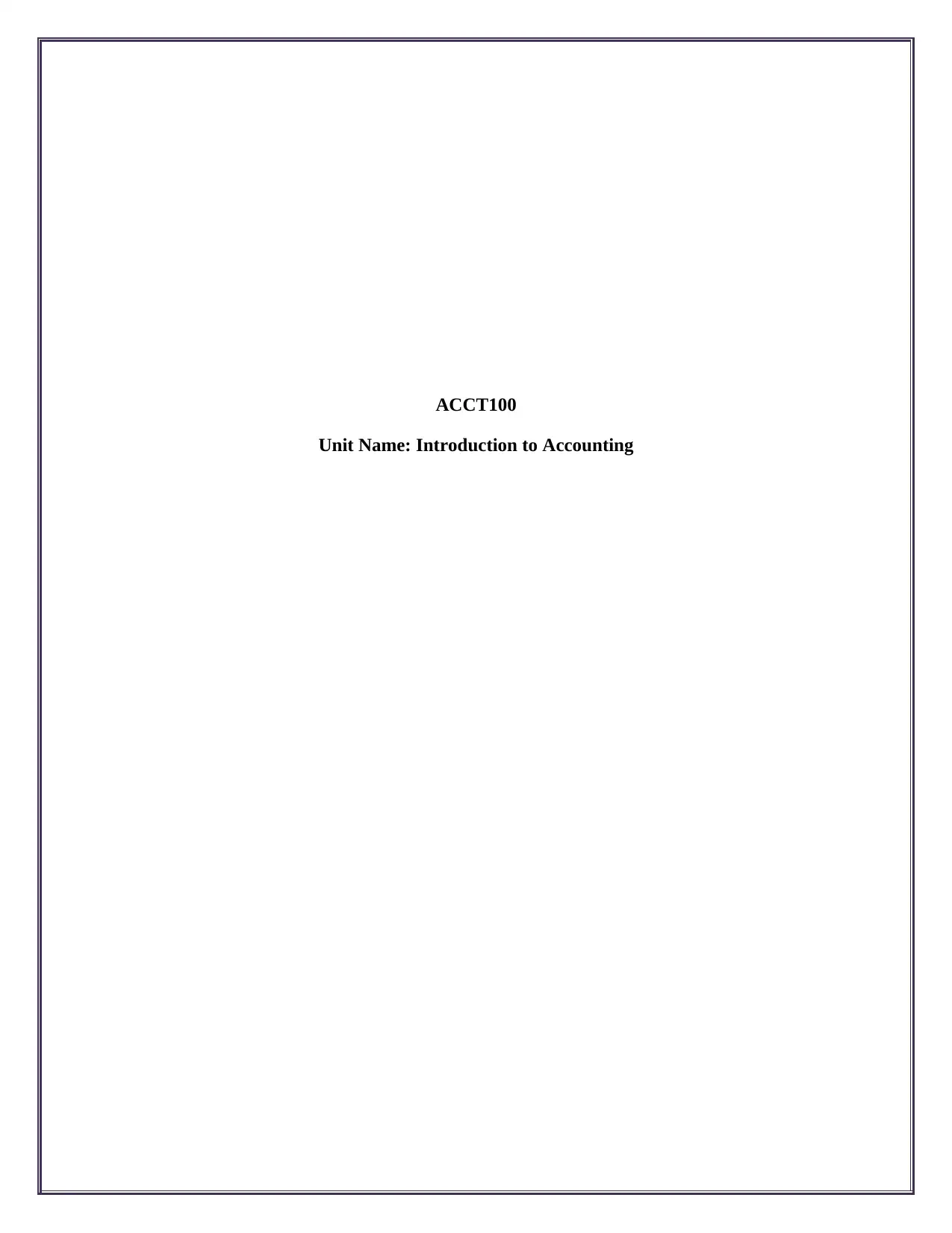
ACCT100
Unit Name: Introduction to Accounting
Unit Name: Introduction to Accounting
Secure Best Marks with AI Grader
Need help grading? Try our AI Grader for instant feedback on your assignments.
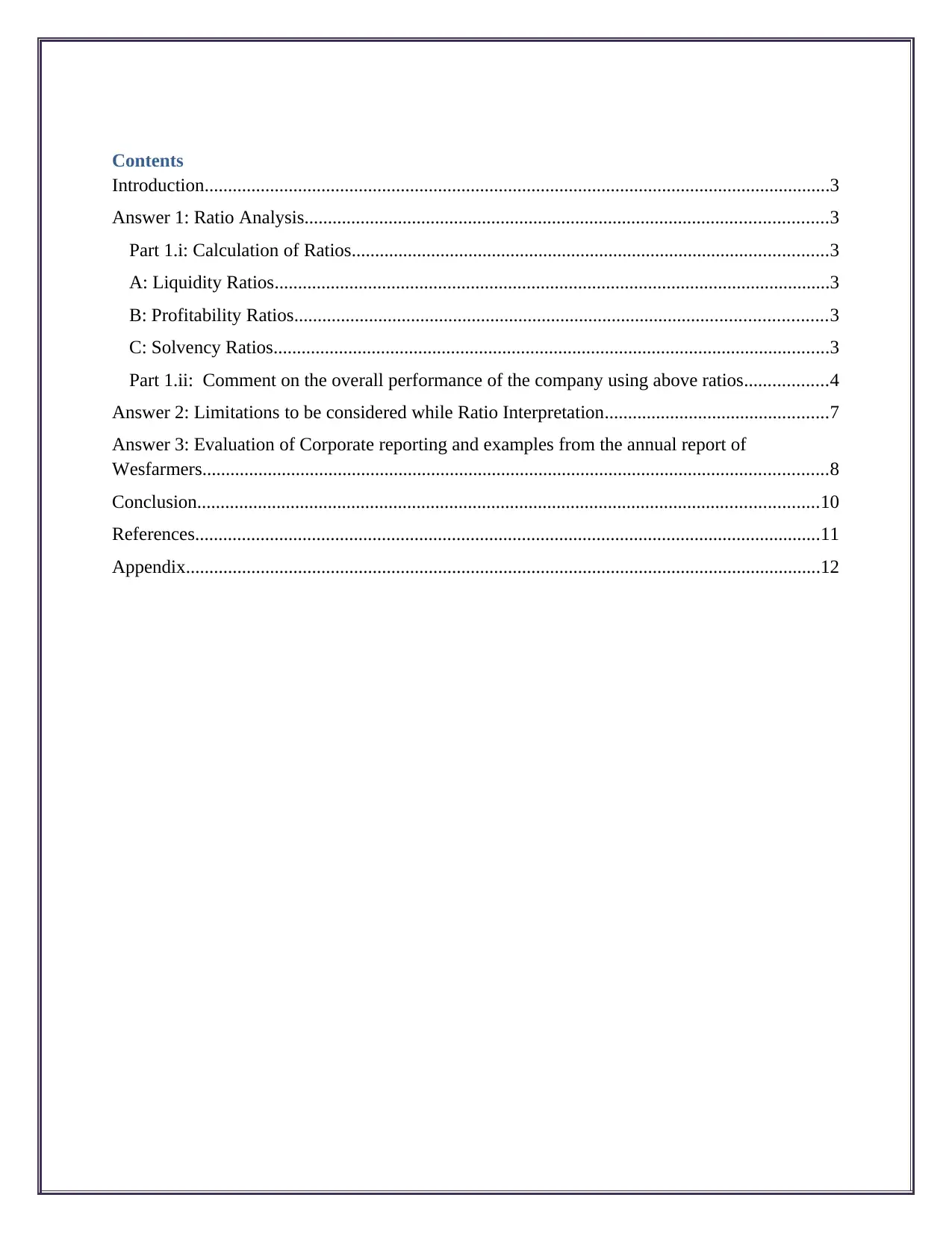
Contents
Introduction......................................................................................................................................3
Answer 1: Ratio Analysis................................................................................................................3
Part 1.i: Calculation of Ratios......................................................................................................3
A: Liquidity Ratios.......................................................................................................................3
B: Profitability Ratios..................................................................................................................3
C: Solvency Ratios.......................................................................................................................3
Part 1.ii: Comment on the overall performance of the company using above ratios..................4
Answer 2: Limitations to be considered while Ratio Interpretation................................................7
Answer 3: Evaluation of Corporate reporting and examples from the annual report of
Wesfarmers......................................................................................................................................8
Conclusion.....................................................................................................................................10
References......................................................................................................................................11
Appendix........................................................................................................................................12
Introduction......................................................................................................................................3
Answer 1: Ratio Analysis................................................................................................................3
Part 1.i: Calculation of Ratios......................................................................................................3
A: Liquidity Ratios.......................................................................................................................3
B: Profitability Ratios..................................................................................................................3
C: Solvency Ratios.......................................................................................................................3
Part 1.ii: Comment on the overall performance of the company using above ratios..................4
Answer 2: Limitations to be considered while Ratio Interpretation................................................7
Answer 3: Evaluation of Corporate reporting and examples from the annual report of
Wesfarmers......................................................................................................................................8
Conclusion.....................................................................................................................................10
References......................................................................................................................................11
Appendix........................................................................................................................................12
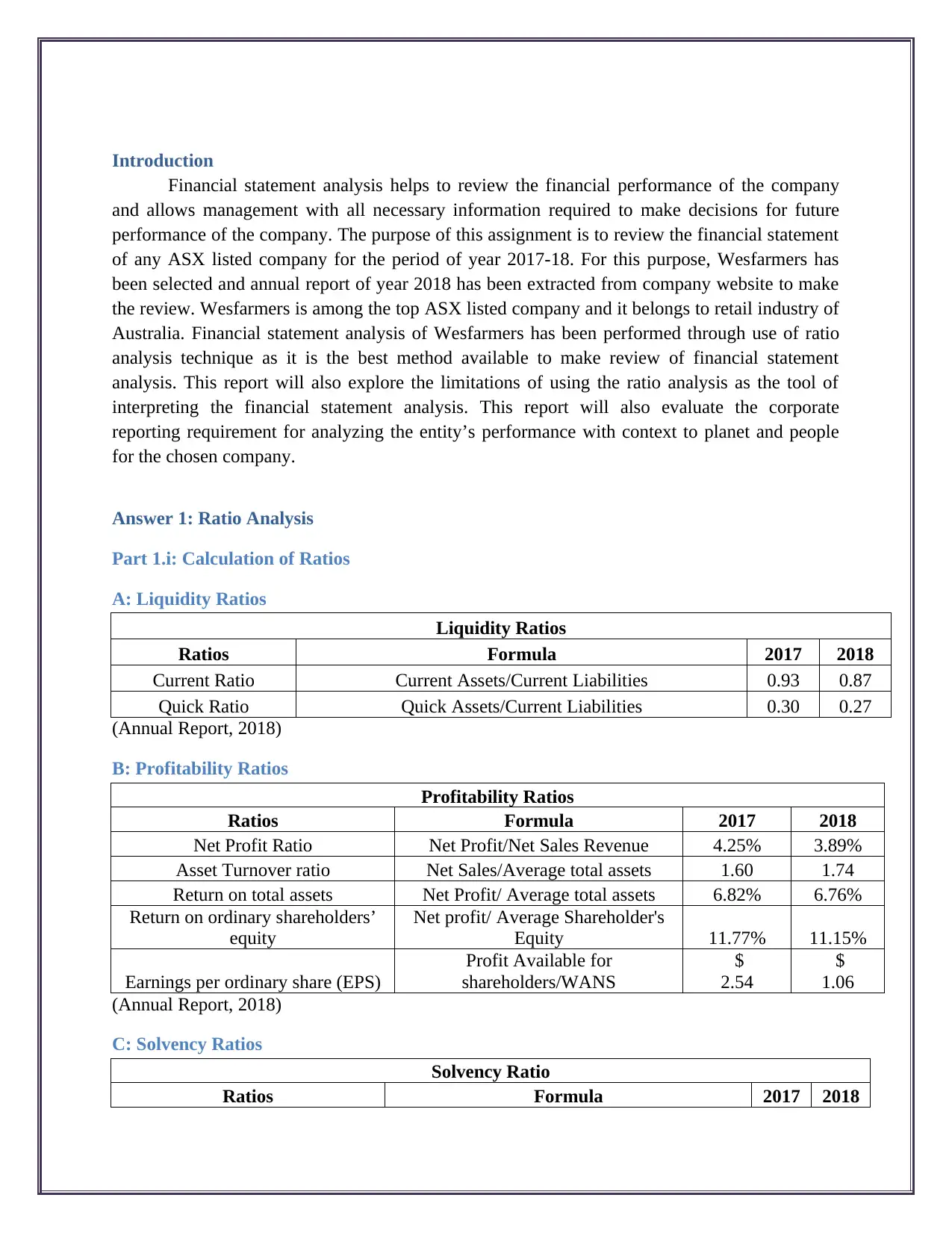
Introduction
Financial statement analysis helps to review the financial performance of the company
and allows management with all necessary information required to make decisions for future
performance of the company. The purpose of this assignment is to review the financial statement
of any ASX listed company for the period of year 2017-18. For this purpose, Wesfarmers has
been selected and annual report of year 2018 has been extracted from company website to make
the review. Wesfarmers is among the top ASX listed company and it belongs to retail industry of
Australia. Financial statement analysis of Wesfarmers has been performed through use of ratio
analysis technique as it is the best method available to make review of financial statement
analysis. This report will also explore the limitations of using the ratio analysis as the tool of
interpreting the financial statement analysis. This report will also evaluate the corporate
reporting requirement for analyzing the entity’s performance with context to planet and people
for the chosen company.
Answer 1: Ratio Analysis
Part 1.i: Calculation of Ratios
A: Liquidity Ratios
Liquidity Ratios
Ratios Formula 2017 2018
Current Ratio Current Assets/Current Liabilities 0.93 0.87
Quick Ratio Quick Assets/Current Liabilities 0.30 0.27
(Annual Report, 2018)
B: Profitability Ratios
Profitability Ratios
Ratios Formula 2017 2018
Net Profit Ratio Net Profit/Net Sales Revenue 4.25% 3.89%
Asset Turnover ratio Net Sales/Average total assets 1.60 1.74
Return on total assets Net Profit/ Average total assets 6.82% 6.76%
Return on ordinary shareholders’
equity
Net profit/ Average Shareholder's
Equity 11.77% 11.15%
Earnings per ordinary share (EPS)
Profit Available for
shareholders/WANS
$
2.54
$
1.06
(Annual Report, 2018)
C: Solvency Ratios
Solvency Ratio
Ratios Formula 2017 2018
Financial statement analysis helps to review the financial performance of the company
and allows management with all necessary information required to make decisions for future
performance of the company. The purpose of this assignment is to review the financial statement
of any ASX listed company for the period of year 2017-18. For this purpose, Wesfarmers has
been selected and annual report of year 2018 has been extracted from company website to make
the review. Wesfarmers is among the top ASX listed company and it belongs to retail industry of
Australia. Financial statement analysis of Wesfarmers has been performed through use of ratio
analysis technique as it is the best method available to make review of financial statement
analysis. This report will also explore the limitations of using the ratio analysis as the tool of
interpreting the financial statement analysis. This report will also evaluate the corporate
reporting requirement for analyzing the entity’s performance with context to planet and people
for the chosen company.
Answer 1: Ratio Analysis
Part 1.i: Calculation of Ratios
A: Liquidity Ratios
Liquidity Ratios
Ratios Formula 2017 2018
Current Ratio Current Assets/Current Liabilities 0.93 0.87
Quick Ratio Quick Assets/Current Liabilities 0.30 0.27
(Annual Report, 2018)
B: Profitability Ratios
Profitability Ratios
Ratios Formula 2017 2018
Net Profit Ratio Net Profit/Net Sales Revenue 4.25% 3.89%
Asset Turnover ratio Net Sales/Average total assets 1.60 1.74
Return on total assets Net Profit/ Average total assets 6.82% 6.76%
Return on ordinary shareholders’
equity
Net profit/ Average Shareholder's
Equity 11.77% 11.15%
Earnings per ordinary share (EPS)
Profit Available for
shareholders/WANS
$
2.54
$
1.06
(Annual Report, 2018)
C: Solvency Ratios
Solvency Ratio
Ratios Formula 2017 2018
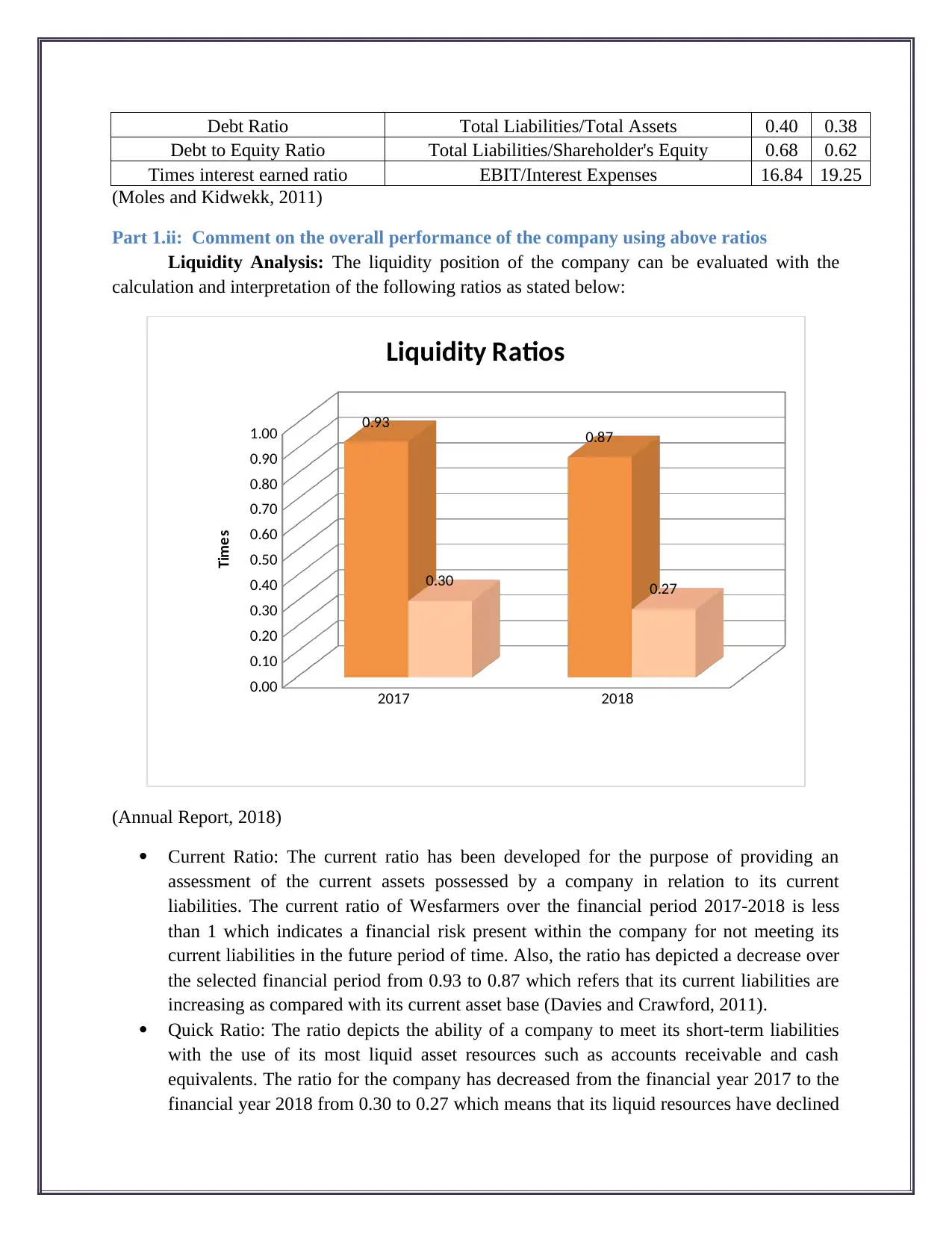
Debt Ratio Total Liabilities/Total Assets 0.40 0.38
Debt to Equity Ratio Total Liabilities/Shareholder's Equity 0.68 0.62
Times interest earned ratio EBIT/Interest Expenses 16.84 19.25
(Moles and Kidwekk, 2011)
Part 1.ii: Comment on the overall performance of the company using above ratios
Liquidity Analysis: The liquidity position of the company can be evaluated with the
calculation and interpretation of the following ratios as stated below:
2017 2018
0.00
0.10
0.20
0.30
0.40
0.50
0.60
0.70
0.80
0.90
1.00 0.93 0.87
0.30 0.27
Liquidity Ratios
Times
(Annual Report, 2018)
Current Ratio: The current ratio has been developed for the purpose of providing an
assessment of the current assets possessed by a company in relation to its current
liabilities. The current ratio of Wesfarmers over the financial period 2017-2018 is less
than 1 which indicates a financial risk present within the company for not meeting its
current liabilities in the future period of time. Also, the ratio has depicted a decrease over
the selected financial period from 0.93 to 0.87 which refers that its current liabilities are
increasing as compared with its current asset base (Davies and Crawford, 2011).
Quick Ratio: The ratio depicts the ability of a company to meet its short-term liabilities
with the use of its most liquid asset resources such as accounts receivable and cash
equivalents. The ratio for the company has decreased from the financial year 2017 to the
financial year 2018 from 0.30 to 0.27 which means that its liquid resources have declined
Debt to Equity Ratio Total Liabilities/Shareholder's Equity 0.68 0.62
Times interest earned ratio EBIT/Interest Expenses 16.84 19.25
(Moles and Kidwekk, 2011)
Part 1.ii: Comment on the overall performance of the company using above ratios
Liquidity Analysis: The liquidity position of the company can be evaluated with the
calculation and interpretation of the following ratios as stated below:
2017 2018
0.00
0.10
0.20
0.30
0.40
0.50
0.60
0.70
0.80
0.90
1.00 0.93 0.87
0.30 0.27
Liquidity Ratios
Times
(Annual Report, 2018)
Current Ratio: The current ratio has been developed for the purpose of providing an
assessment of the current assets possessed by a company in relation to its current
liabilities. The current ratio of Wesfarmers over the financial period 2017-2018 is less
than 1 which indicates a financial risk present within the company for not meeting its
current liabilities in the future period of time. Also, the ratio has depicted a decrease over
the selected financial period from 0.93 to 0.87 which refers that its current liabilities are
increasing as compared with its current asset base (Davies and Crawford, 2011).
Quick Ratio: The ratio depicts the ability of a company to meet its short-term liabilities
with the use of its most liquid asset resources such as accounts receivable and cash
equivalents. The ratio for the company has decreased from the financial year 2017 to the
financial year 2018 from 0.30 to 0.27 which means that its liquid resources have declined
Secure Best Marks with AI Grader
Need help grading? Try our AI Grader for instant feedback on your assignments.
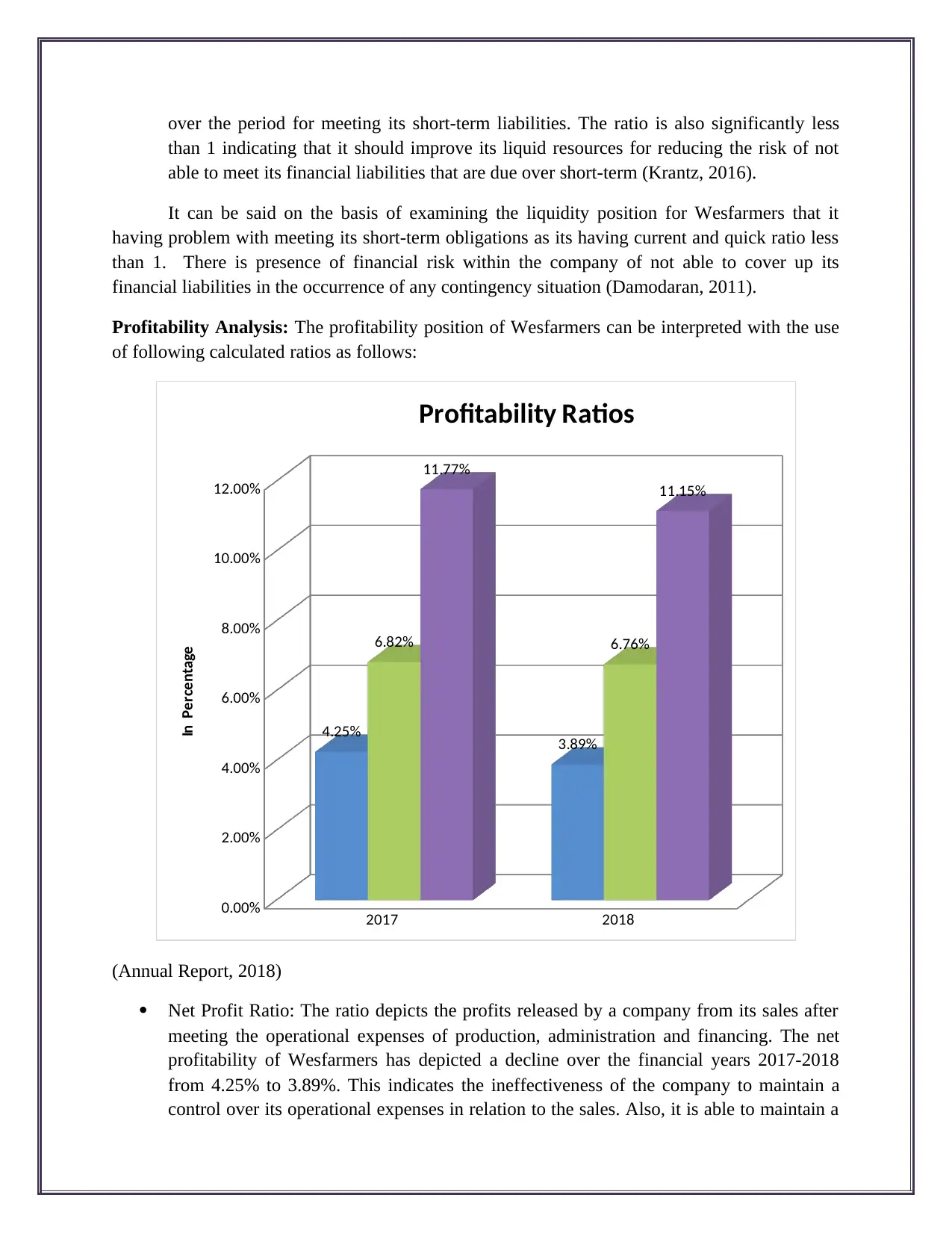
over the period for meeting its short-term liabilities. The ratio is also significantly less
than 1 indicating that it should improve its liquid resources for reducing the risk of not
able to meet its financial liabilities that are due over short-term (Krantz, 2016).
It can be said on the basis of examining the liquidity position for Wesfarmers that it
having problem with meeting its short-term obligations as its having current and quick ratio less
than 1. There is presence of financial risk within the company of not able to cover up its
financial liabilities in the occurrence of any contingency situation (Damodaran, 2011).
Profitability Analysis: The profitability position of Wesfarmers can be interpreted with the use
of following calculated ratios as follows:
2017 2018
0.00%
2.00%
4.00%
6.00%
8.00%
10.00%
12.00%
4.25% 3.89%
6.82% 6.76%
11.77%
11.15%
Profitability Ratios
In Percentage
(Annual Report, 2018)
Net Profit Ratio: The ratio depicts the profits released by a company from its sales after
meeting the operational expenses of production, administration and financing. The net
profitability of Wesfarmers has depicted a decline over the financial years 2017-2018
from 4.25% to 3.89%. This indicates the ineffectiveness of the company to maintain a
control over its operational expenses in relation to the sales. Also, it is able to maintain a
than 1 indicating that it should improve its liquid resources for reducing the risk of not
able to meet its financial liabilities that are due over short-term (Krantz, 2016).
It can be said on the basis of examining the liquidity position for Wesfarmers that it
having problem with meeting its short-term obligations as its having current and quick ratio less
than 1. There is presence of financial risk within the company of not able to cover up its
financial liabilities in the occurrence of any contingency situation (Damodaran, 2011).
Profitability Analysis: The profitability position of Wesfarmers can be interpreted with the use
of following calculated ratios as follows:
2017 2018
0.00%
2.00%
4.00%
6.00%
8.00%
10.00%
12.00%
4.25% 3.89%
6.82% 6.76%
11.77%
11.15%
Profitability Ratios
In Percentage
(Annual Report, 2018)
Net Profit Ratio: The ratio depicts the profits released by a company from its sales after
meeting the operational expenses of production, administration and financing. The net
profitability of Wesfarmers has depicted a decline over the financial years 2017-2018
from 4.25% to 3.89%. This indicates the ineffectiveness of the company to maintain a
control over its operational expenses in relation to the sales. Also, it is able to maintain a
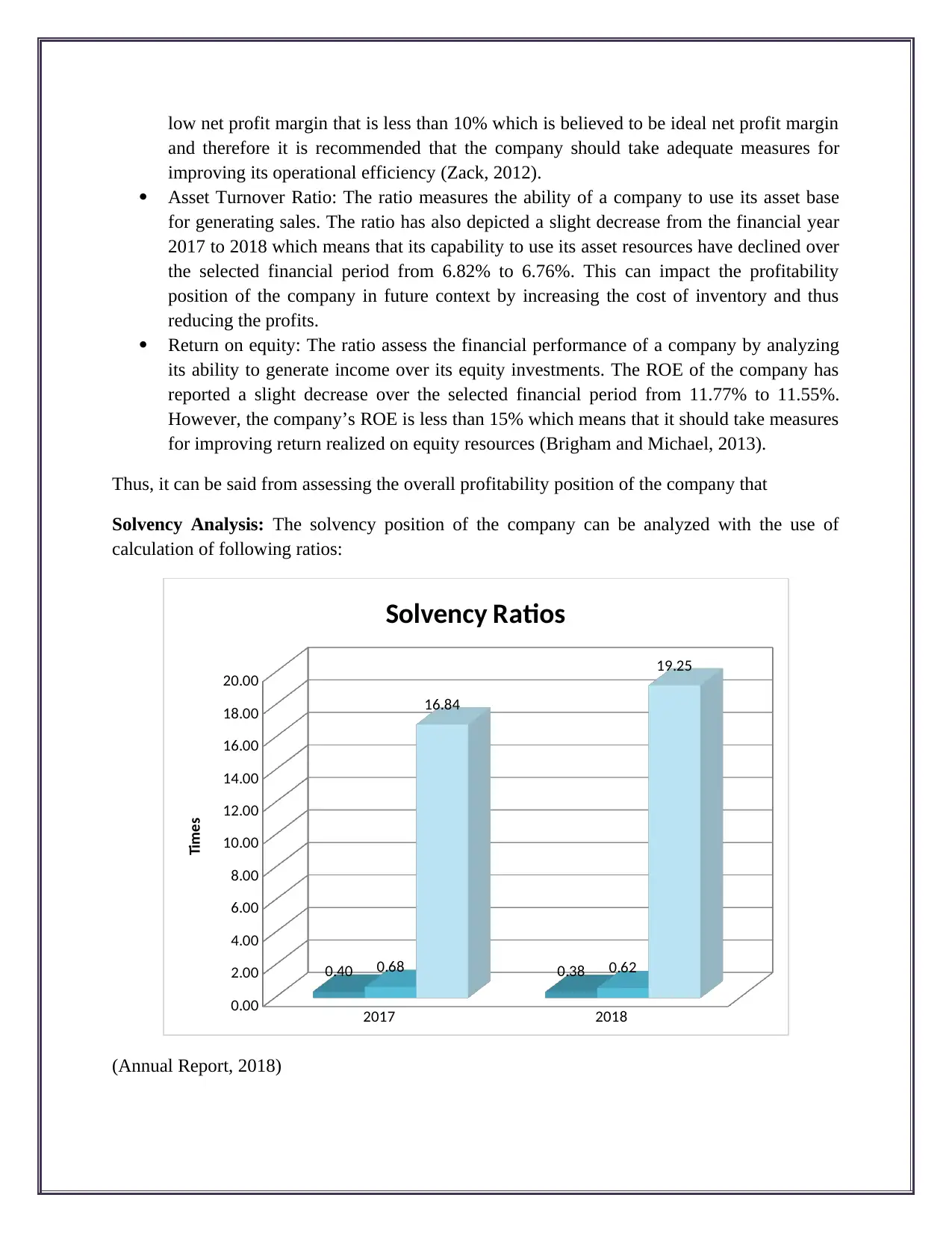
low net profit margin that is less than 10% which is believed to be ideal net profit margin
and therefore it is recommended that the company should take adequate measures for
improving its operational efficiency (Zack, 2012).
Asset Turnover Ratio: The ratio measures the ability of a company to use its asset base
for generating sales. The ratio has also depicted a slight decrease from the financial year
2017 to 2018 which means that its capability to use its asset resources have declined over
the selected financial period from 6.82% to 6.76%. This can impact the profitability
position of the company in future context by increasing the cost of inventory and thus
reducing the profits.
Return on equity: The ratio assess the financial performance of a company by analyzing
its ability to generate income over its equity investments. The ROE of the company has
reported a slight decrease over the selected financial period from 11.77% to 11.55%.
However, the company’s ROE is less than 15% which means that it should take measures
for improving return realized on equity resources (Brigham and Michael, 2013).
Thus, it can be said from assessing the overall profitability position of the company that
Solvency Analysis: The solvency position of the company can be analyzed with the use of
calculation of following ratios:
2017 2018
0.00
2.00
4.00
6.00
8.00
10.00
12.00
14.00
16.00
18.00
20.00
0.40 0.380.68 0.62
16.84
19.25
Solvency Ratios
Times
(Annual Report, 2018)
and therefore it is recommended that the company should take adequate measures for
improving its operational efficiency (Zack, 2012).
Asset Turnover Ratio: The ratio measures the ability of a company to use its asset base
for generating sales. The ratio has also depicted a slight decrease from the financial year
2017 to 2018 which means that its capability to use its asset resources have declined over
the selected financial period from 6.82% to 6.76%. This can impact the profitability
position of the company in future context by increasing the cost of inventory and thus
reducing the profits.
Return on equity: The ratio assess the financial performance of a company by analyzing
its ability to generate income over its equity investments. The ROE of the company has
reported a slight decrease over the selected financial period from 11.77% to 11.55%.
However, the company’s ROE is less than 15% which means that it should take measures
for improving return realized on equity resources (Brigham and Michael, 2013).
Thus, it can be said from assessing the overall profitability position of the company that
Solvency Analysis: The solvency position of the company can be analyzed with the use of
calculation of following ratios:
2017 2018
0.00
2.00
4.00
6.00
8.00
10.00
12.00
14.00
16.00
18.00
20.00
0.40 0.380.68 0.62
16.84
19.25
Solvency Ratios
Times
(Annual Report, 2018)
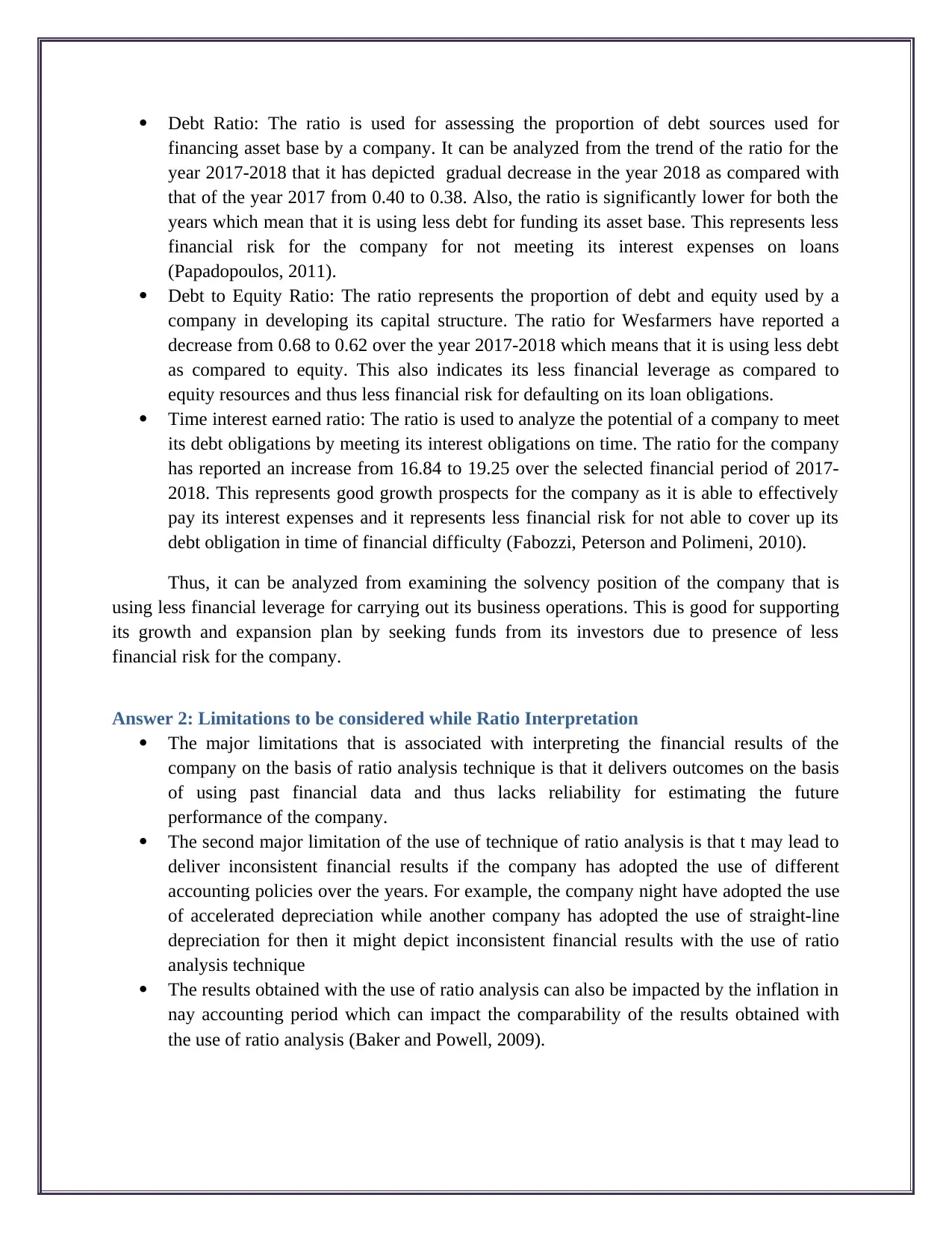
Debt Ratio: The ratio is used for assessing the proportion of debt sources used for
financing asset base by a company. It can be analyzed from the trend of the ratio for the
year 2017-2018 that it has depicted gradual decrease in the year 2018 as compared with
that of the year 2017 from 0.40 to 0.38. Also, the ratio is significantly lower for both the
years which mean that it is using less debt for funding its asset base. This represents less
financial risk for the company for not meeting its interest expenses on loans
(Papadopoulos, 2011).
Debt to Equity Ratio: The ratio represents the proportion of debt and equity used by a
company in developing its capital structure. The ratio for Wesfarmers have reported a
decrease from 0.68 to 0.62 over the year 2017-2018 which means that it is using less debt
as compared to equity. This also indicates its less financial leverage as compared to
equity resources and thus less financial risk for defaulting on its loan obligations.
Time interest earned ratio: The ratio is used to analyze the potential of a company to meet
its debt obligations by meeting its interest obligations on time. The ratio for the company
has reported an increase from 16.84 to 19.25 over the selected financial period of 2017-
2018. This represents good growth prospects for the company as it is able to effectively
pay its interest expenses and it represents less financial risk for not able to cover up its
debt obligation in time of financial difficulty (Fabozzi, Peterson and Polimeni, 2010).
Thus, it can be analyzed from examining the solvency position of the company that is
using less financial leverage for carrying out its business operations. This is good for supporting
its growth and expansion plan by seeking funds from its investors due to presence of less
financial risk for the company.
Answer 2: Limitations to be considered while Ratio Interpretation
The major limitations that is associated with interpreting the financial results of the
company on the basis of ratio analysis technique is that it delivers outcomes on the basis
of using past financial data and thus lacks reliability for estimating the future
performance of the company.
The second major limitation of the use of technique of ratio analysis is that t may lead to
deliver inconsistent financial results if the company has adopted the use of different
accounting policies over the years. For example, the company night have adopted the use
of accelerated depreciation while another company has adopted the use of straight-line
depreciation for then it might depict inconsistent financial results with the use of ratio
analysis technique
The results obtained with the use of ratio analysis can also be impacted by the inflation in
nay accounting period which can impact the comparability of the results obtained with
the use of ratio analysis (Baker and Powell, 2009).
financing asset base by a company. It can be analyzed from the trend of the ratio for the
year 2017-2018 that it has depicted gradual decrease in the year 2018 as compared with
that of the year 2017 from 0.40 to 0.38. Also, the ratio is significantly lower for both the
years which mean that it is using less debt for funding its asset base. This represents less
financial risk for the company for not meeting its interest expenses on loans
(Papadopoulos, 2011).
Debt to Equity Ratio: The ratio represents the proportion of debt and equity used by a
company in developing its capital structure. The ratio for Wesfarmers have reported a
decrease from 0.68 to 0.62 over the year 2017-2018 which means that it is using less debt
as compared to equity. This also indicates its less financial leverage as compared to
equity resources and thus less financial risk for defaulting on its loan obligations.
Time interest earned ratio: The ratio is used to analyze the potential of a company to meet
its debt obligations by meeting its interest obligations on time. The ratio for the company
has reported an increase from 16.84 to 19.25 over the selected financial period of 2017-
2018. This represents good growth prospects for the company as it is able to effectively
pay its interest expenses and it represents less financial risk for not able to cover up its
debt obligation in time of financial difficulty (Fabozzi, Peterson and Polimeni, 2010).
Thus, it can be analyzed from examining the solvency position of the company that is
using less financial leverage for carrying out its business operations. This is good for supporting
its growth and expansion plan by seeking funds from its investors due to presence of less
financial risk for the company.
Answer 2: Limitations to be considered while Ratio Interpretation
The major limitations that is associated with interpreting the financial results of the
company on the basis of ratio analysis technique is that it delivers outcomes on the basis
of using past financial data and thus lacks reliability for estimating the future
performance of the company.
The second major limitation of the use of technique of ratio analysis is that t may lead to
deliver inconsistent financial results if the company has adopted the use of different
accounting policies over the years. For example, the company night have adopted the use
of accelerated depreciation while another company has adopted the use of straight-line
depreciation for then it might depict inconsistent financial results with the use of ratio
analysis technique
The results obtained with the use of ratio analysis can also be impacted by the inflation in
nay accounting period which can impact the comparability of the results obtained with
the use of ratio analysis (Baker and Powell, 2009).
Paraphrase This Document
Need a fresh take? Get an instant paraphrase of this document with our AI Paraphraser
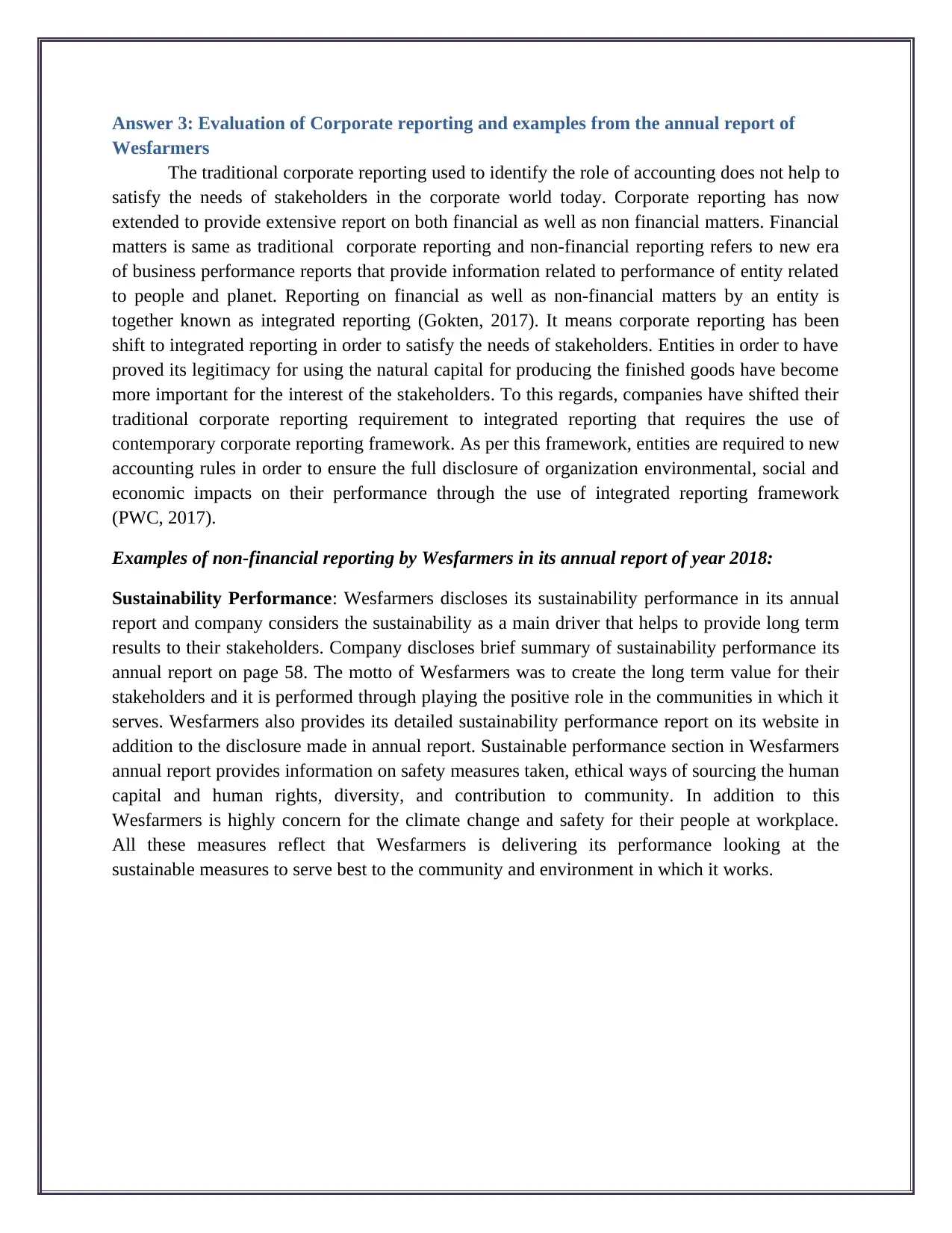
Answer 3: Evaluation of Corporate reporting and examples from the annual report of
Wesfarmers
The traditional corporate reporting used to identify the role of accounting does not help to
satisfy the needs of stakeholders in the corporate world today. Corporate reporting has now
extended to provide extensive report on both financial as well as non financial matters. Financial
matters is same as traditional corporate reporting and non-financial reporting refers to new era
of business performance reports that provide information related to performance of entity related
to people and planet. Reporting on financial as well as non-financial matters by an entity is
together known as integrated reporting (Gokten, 2017). It means corporate reporting has been
shift to integrated reporting in order to satisfy the needs of stakeholders. Entities in order to have
proved its legitimacy for using the natural capital for producing the finished goods have become
more important for the interest of the stakeholders. To this regards, companies have shifted their
traditional corporate reporting requirement to integrated reporting that requires the use of
contemporary corporate reporting framework. As per this framework, entities are required to new
accounting rules in order to ensure the full disclosure of organization environmental, social and
economic impacts on their performance through the use of integrated reporting framework
(PWC, 2017).
Examples of non-financial reporting by Wesfarmers in its annual report of year 2018:
Sustainability Performance: Wesfarmers discloses its sustainability performance in its annual
report and company considers the sustainability as a main driver that helps to provide long term
results to their stakeholders. Company discloses brief summary of sustainability performance its
annual report on page 58. The motto of Wesfarmers was to create the long term value for their
stakeholders and it is performed through playing the positive role in the communities in which it
serves. Wesfarmers also provides its detailed sustainability performance report on its website in
addition to the disclosure made in annual report. Sustainable performance section in Wesfarmers
annual report provides information on safety measures taken, ethical ways of sourcing the human
capital and human rights, diversity, and contribution to community. In addition to this
Wesfarmers is highly concern for the climate change and safety for their people at workplace.
All these measures reflect that Wesfarmers is delivering its performance looking at the
sustainable measures to serve best to the community and environment in which it works.
Wesfarmers
The traditional corporate reporting used to identify the role of accounting does not help to
satisfy the needs of stakeholders in the corporate world today. Corporate reporting has now
extended to provide extensive report on both financial as well as non financial matters. Financial
matters is same as traditional corporate reporting and non-financial reporting refers to new era
of business performance reports that provide information related to performance of entity related
to people and planet. Reporting on financial as well as non-financial matters by an entity is
together known as integrated reporting (Gokten, 2017). It means corporate reporting has been
shift to integrated reporting in order to satisfy the needs of stakeholders. Entities in order to have
proved its legitimacy for using the natural capital for producing the finished goods have become
more important for the interest of the stakeholders. To this regards, companies have shifted their
traditional corporate reporting requirement to integrated reporting that requires the use of
contemporary corporate reporting framework. As per this framework, entities are required to new
accounting rules in order to ensure the full disclosure of organization environmental, social and
economic impacts on their performance through the use of integrated reporting framework
(PWC, 2017).
Examples of non-financial reporting by Wesfarmers in its annual report of year 2018:
Sustainability Performance: Wesfarmers discloses its sustainability performance in its annual
report and company considers the sustainability as a main driver that helps to provide long term
results to their stakeholders. Company discloses brief summary of sustainability performance its
annual report on page 58. The motto of Wesfarmers was to create the long term value for their
stakeholders and it is performed through playing the positive role in the communities in which it
serves. Wesfarmers also provides its detailed sustainability performance report on its website in
addition to the disclosure made in annual report. Sustainable performance section in Wesfarmers
annual report provides information on safety measures taken, ethical ways of sourcing the human
capital and human rights, diversity, and contribution to community. In addition to this
Wesfarmers is highly concern for the climate change and safety for their people at workplace.
All these measures reflect that Wesfarmers is delivering its performance looking at the
sustainable measures to serve best to the community and environment in which it works.
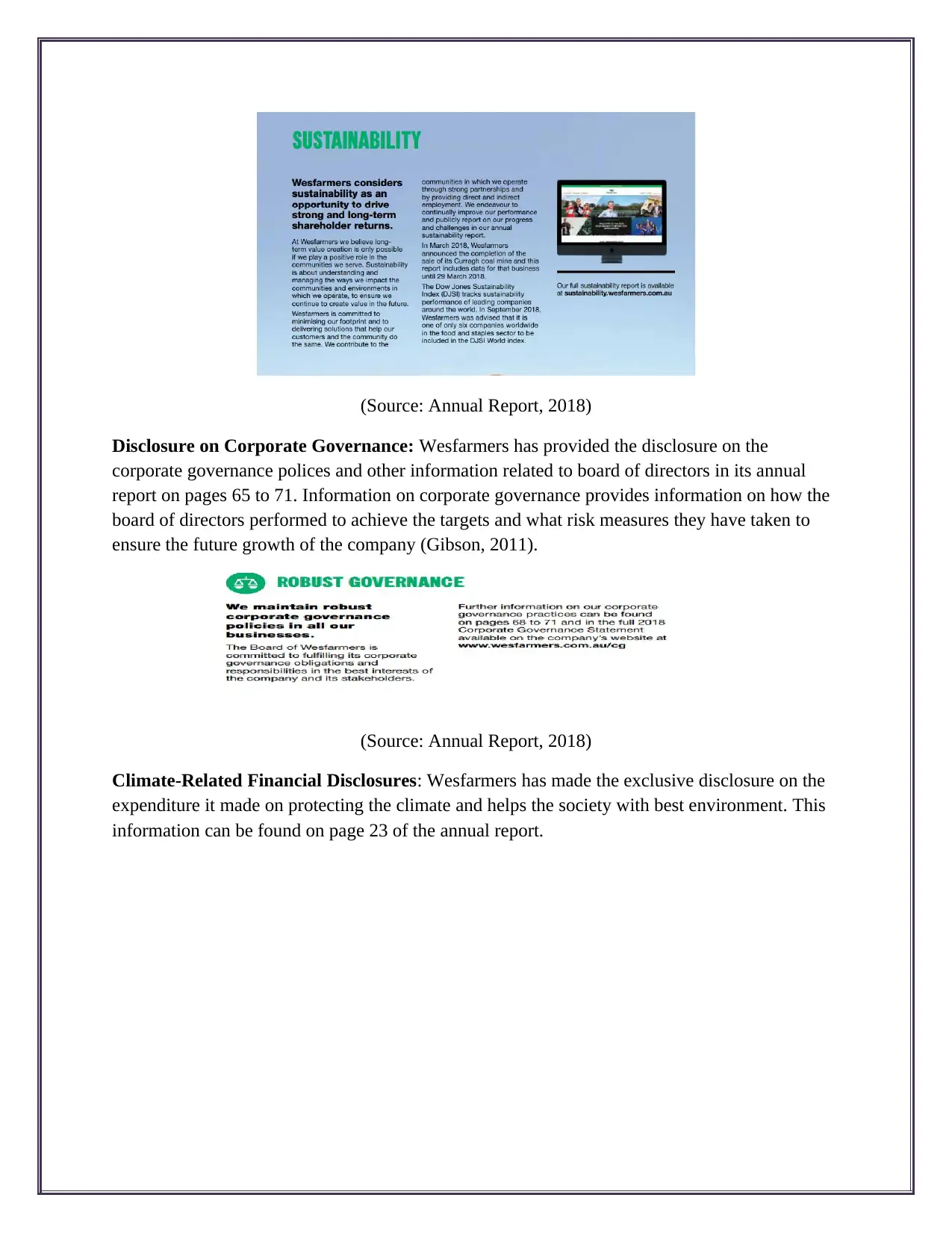
(Source: Annual Report, 2018)
Disclosure on Corporate Governance: Wesfarmers has provided the disclosure on the
corporate governance polices and other information related to board of directors in its annual
report on pages 65 to 71. Information on corporate governance provides information on how the
board of directors performed to achieve the targets and what risk measures they have taken to
ensure the future growth of the company (Gibson, 2011).
(Source: Annual Report, 2018)
Climate-Related Financial Disclosures: Wesfarmers has made the exclusive disclosure on the
expenditure it made on protecting the climate and helps the society with best environment. This
information can be found on page 23 of the annual report.
Disclosure on Corporate Governance: Wesfarmers has provided the disclosure on the
corporate governance polices and other information related to board of directors in its annual
report on pages 65 to 71. Information on corporate governance provides information on how the
board of directors performed to achieve the targets and what risk measures they have taken to
ensure the future growth of the company (Gibson, 2011).
(Source: Annual Report, 2018)
Climate-Related Financial Disclosures: Wesfarmers has made the exclusive disclosure on the
expenditure it made on protecting the climate and helps the society with best environment. This
information can be found on page 23 of the annual report.
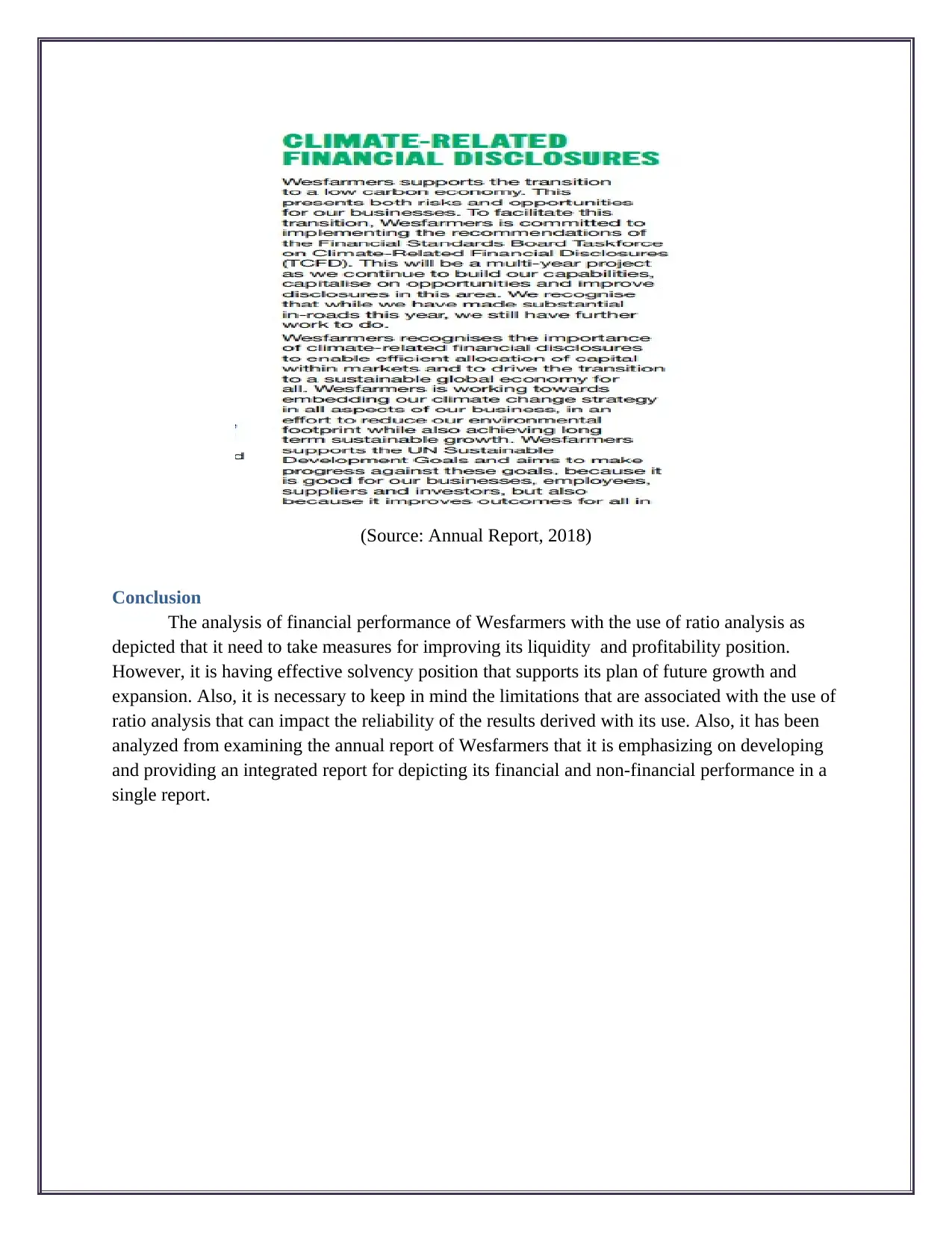
(Source: Annual Report, 2018)
Conclusion
The analysis of financial performance of Wesfarmers with the use of ratio analysis as
depicted that it need to take measures for improving its liquidity and profitability position.
However, it is having effective solvency position that supports its plan of future growth and
expansion. Also, it is necessary to keep in mind the limitations that are associated with the use of
ratio analysis that can impact the reliability of the results derived with its use. Also, it has been
analyzed from examining the annual report of Wesfarmers that it is emphasizing on developing
and providing an integrated report for depicting its financial and non-financial performance in a
single report.
Conclusion
The analysis of financial performance of Wesfarmers with the use of ratio analysis as
depicted that it need to take measures for improving its liquidity and profitability position.
However, it is having effective solvency position that supports its plan of future growth and
expansion. Also, it is necessary to keep in mind the limitations that are associated with the use of
ratio analysis that can impact the reliability of the results derived with its use. Also, it has been
analyzed from examining the annual report of Wesfarmers that it is emphasizing on developing
and providing an integrated report for depicting its financial and non-financial performance in a
single report.
Secure Best Marks with AI Grader
Need help grading? Try our AI Grader for instant feedback on your assignments.
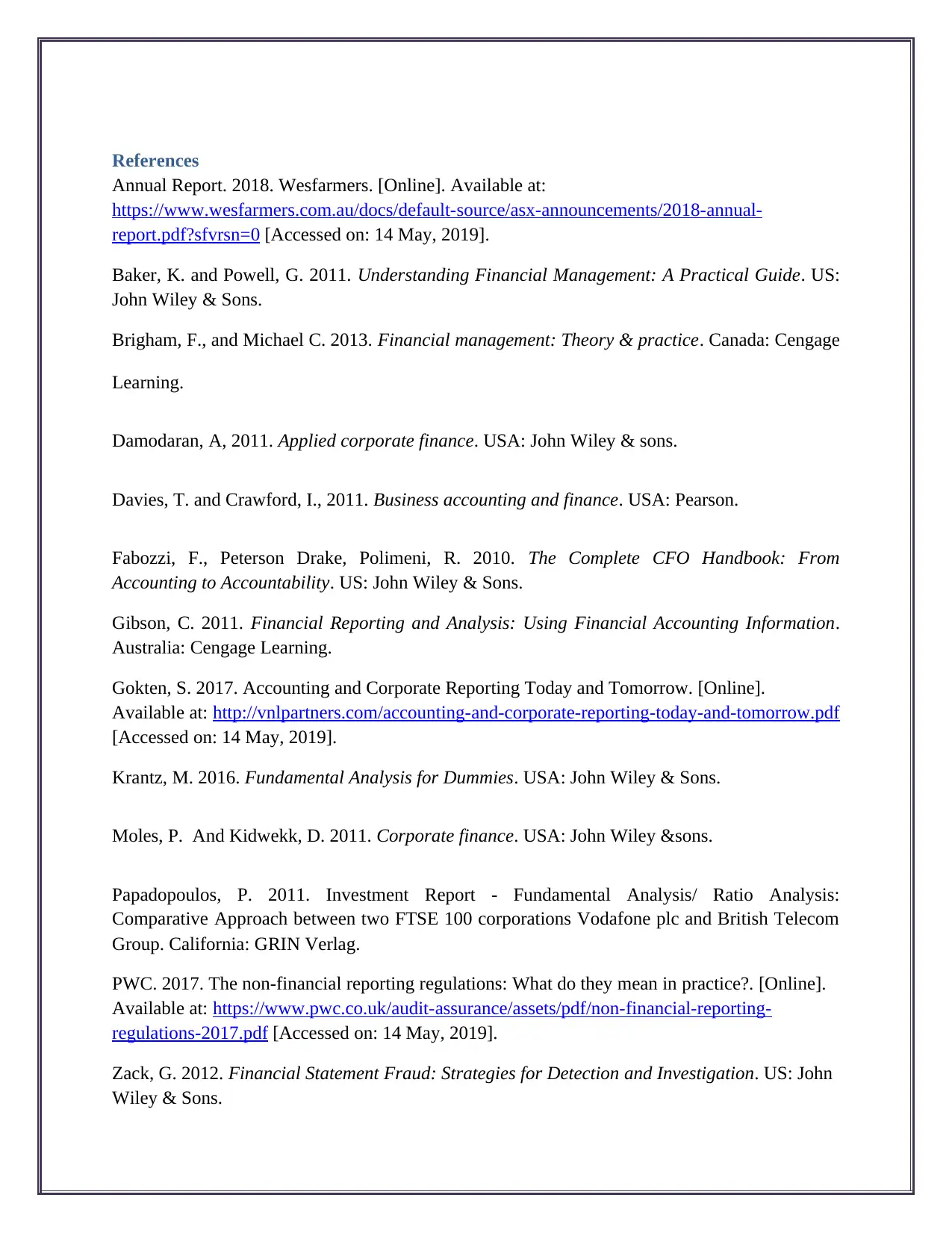
References
Annual Report. 2018. Wesfarmers. [Online]. Available at:
https://www.wesfarmers.com.au/docs/default-source/asx-announcements/2018-annual-
report.pdf?sfvrsn=0 [Accessed on: 14 May, 2019].
Baker, K. and Powell, G. 2011. Understanding Financial Management: A Practical Guide. US:
John Wiley & Sons.
Brigham, F., and Michael C. 2013. Financial management: Theory & practice. Canada: Cengage
Learning.
Damodaran, A, 2011. Applied corporate finance. USA: John Wiley & sons.
Davies, T. and Crawford, I., 2011. Business accounting and finance. USA: Pearson.
Fabozzi, F., Peterson Drake, Polimeni, R. 2010. The Complete CFO Handbook: From
Accounting to Accountability. US: John Wiley & Sons.
Gibson, C. 2011. Financial Reporting and Analysis: Using Financial Accounting Information.
Australia: Cengage Learning.
Gokten, S. 2017. Accounting and Corporate Reporting Today and Tomorrow. [Online].
Available at: http://vnlpartners.com/accounting-and-corporate-reporting-today-and-tomorrow.pdf
[Accessed on: 14 May, 2019].
Krantz, M. 2016. Fundamental Analysis for Dummies. USA: John Wiley & Sons.
Moles, P. And Kidwekk, D. 2011. Corporate finance. USA: John Wiley &sons.
Papadopoulos, P. 2011. Investment Report - Fundamental Analysis/ Ratio Analysis:
Comparative Approach between two FTSE 100 corporations Vodafone plc and British Telecom
Group. California: GRIN Verlag.
PWC. 2017. The non-financial reporting regulations: What do they mean in practice?. [Online].
Available at: https://www.pwc.co.uk/audit-assurance/assets/pdf/non-financial-reporting-
regulations-2017.pdf [Accessed on: 14 May, 2019].
Zack, G. 2012. Financial Statement Fraud: Strategies for Detection and Investigation. US: John
Wiley & Sons.
Annual Report. 2018. Wesfarmers. [Online]. Available at:
https://www.wesfarmers.com.au/docs/default-source/asx-announcements/2018-annual-
report.pdf?sfvrsn=0 [Accessed on: 14 May, 2019].
Baker, K. and Powell, G. 2011. Understanding Financial Management: A Practical Guide. US:
John Wiley & Sons.
Brigham, F., and Michael C. 2013. Financial management: Theory & practice. Canada: Cengage
Learning.
Damodaran, A, 2011. Applied corporate finance. USA: John Wiley & sons.
Davies, T. and Crawford, I., 2011. Business accounting and finance. USA: Pearson.
Fabozzi, F., Peterson Drake, Polimeni, R. 2010. The Complete CFO Handbook: From
Accounting to Accountability. US: John Wiley & Sons.
Gibson, C. 2011. Financial Reporting and Analysis: Using Financial Accounting Information.
Australia: Cengage Learning.
Gokten, S. 2017. Accounting and Corporate Reporting Today and Tomorrow. [Online].
Available at: http://vnlpartners.com/accounting-and-corporate-reporting-today-and-tomorrow.pdf
[Accessed on: 14 May, 2019].
Krantz, M. 2016. Fundamental Analysis for Dummies. USA: John Wiley & Sons.
Moles, P. And Kidwekk, D. 2011. Corporate finance. USA: John Wiley &sons.
Papadopoulos, P. 2011. Investment Report - Fundamental Analysis/ Ratio Analysis:
Comparative Approach between two FTSE 100 corporations Vodafone plc and British Telecom
Group. California: GRIN Verlag.
PWC. 2017. The non-financial reporting regulations: What do they mean in practice?. [Online].
Available at: https://www.pwc.co.uk/audit-assurance/assets/pdf/non-financial-reporting-
regulations-2017.pdf [Accessed on: 14 May, 2019].
Zack, G. 2012. Financial Statement Fraud: Strategies for Detection and Investigation. US: John
Wiley & Sons.

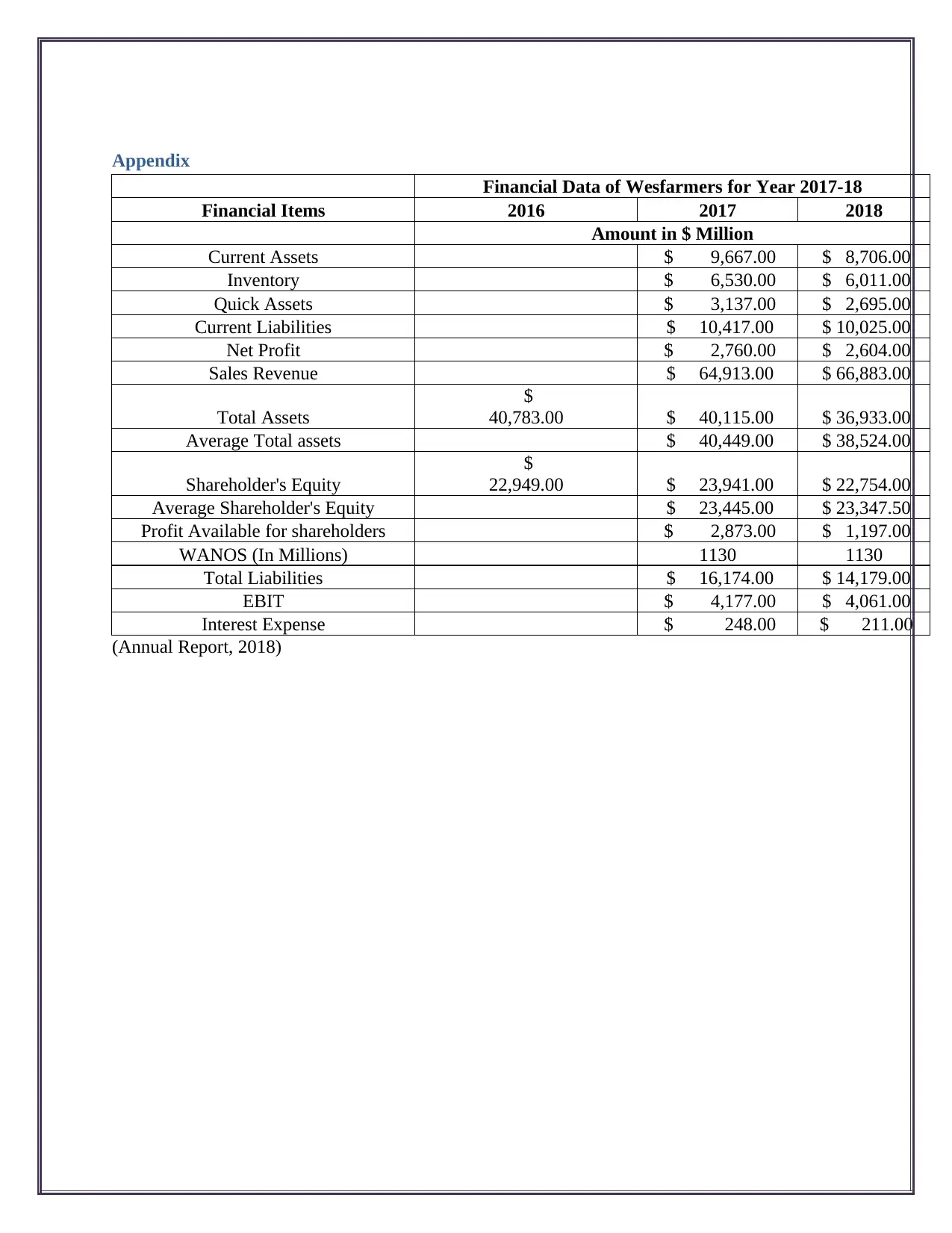
Appendix
Financial Data of Wesfarmers for Year 2017-18
Financial Items 2016 2017 2018
Amount in $ Million
Current Assets $ 9,667.00 $ 8,706.00
Inventory $ 6,530.00 $ 6,011.00
Quick Assets $ 3,137.00 $ 2,695.00
Current Liabilities $ 10,417.00 $ 10,025.00
Net Profit $ 2,760.00 $ 2,604.00
Sales Revenue $ 64,913.00 $ 66,883.00
Total Assets
$
40,783.00 $ 40,115.00 $ 36,933.00
Average Total assets $ 40,449.00 $ 38,524.00
Shareholder's Equity
$
22,949.00 $ 23,941.00 $ 22,754.00
Average Shareholder's Equity $ 23,445.00 $ 23,347.50
Profit Available for shareholders $ 2,873.00 $ 1,197.00
WANOS (In Millions) 1130 1130
Total Liabilities $ 16,174.00 $ 14,179.00
EBIT $ 4,177.00 $ 4,061.00
Interest Expense $ 248.00 $ 211.00
(Annual Report, 2018)
Financial Data of Wesfarmers for Year 2017-18
Financial Items 2016 2017 2018
Amount in $ Million
Current Assets $ 9,667.00 $ 8,706.00
Inventory $ 6,530.00 $ 6,011.00
Quick Assets $ 3,137.00 $ 2,695.00
Current Liabilities $ 10,417.00 $ 10,025.00
Net Profit $ 2,760.00 $ 2,604.00
Sales Revenue $ 64,913.00 $ 66,883.00
Total Assets
$
40,783.00 $ 40,115.00 $ 36,933.00
Average Total assets $ 40,449.00 $ 38,524.00
Shareholder's Equity
$
22,949.00 $ 23,941.00 $ 22,754.00
Average Shareholder's Equity $ 23,445.00 $ 23,347.50
Profit Available for shareholders $ 2,873.00 $ 1,197.00
WANOS (In Millions) 1130 1130
Total Liabilities $ 16,174.00 $ 14,179.00
EBIT $ 4,177.00 $ 4,061.00
Interest Expense $ 248.00 $ 211.00
(Annual Report, 2018)
1 out of 13
Related Documents
Your All-in-One AI-Powered Toolkit for Academic Success.
+13062052269
info@desklib.com
Available 24*7 on WhatsApp / Email
![[object Object]](/_next/static/media/star-bottom.7253800d.svg)
Unlock your academic potential
© 2024 | Zucol Services PVT LTD | All rights reserved.





